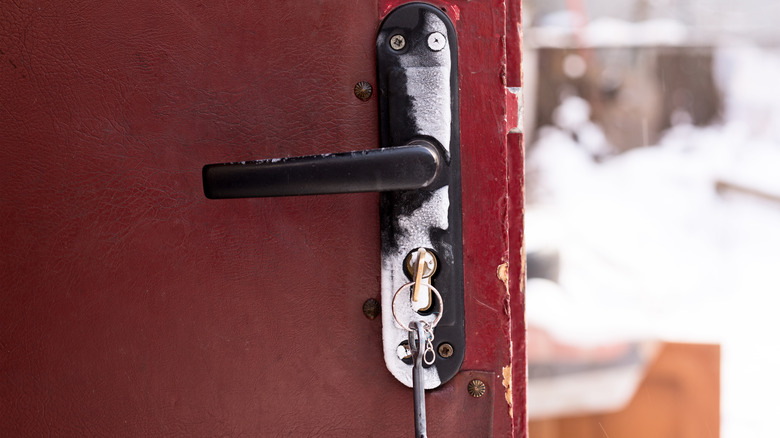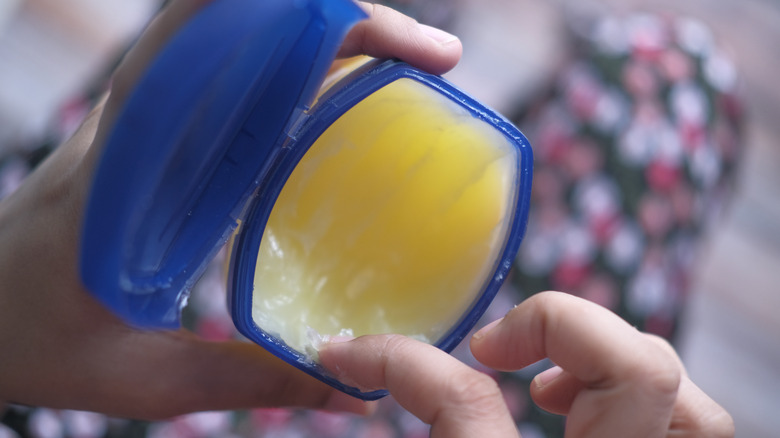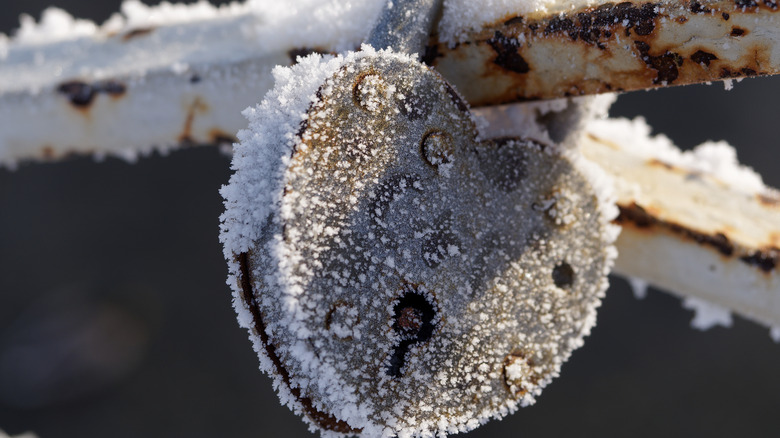Reach For This Medicine Cabinet Staple To Prevent Frozen Locks
You probably know that Vaseline has multiple handy uses around the house, including restoring old wooden furniture and preventing rust on metal tools and hinges. However, petroleum jelly's usefulness doesn't end there. During wintertime, when you may have issues with outdoor locks becoming frozen, a coating of petroleum jelly can keep the locks working smoothly.
Because many people keep Vaseline in their medicine cabinets to help with cracked skin on the hands in winter, and because petroleum jelly can keep for up to 10 years after it's opened, it's not uncommon for people to have this product on hand — you might have some sitting at home right now, meaning you don't even need to make an extra trip to the store to keep your locks from freezing.
Keep in mind that petroleum jelly really only works with locks that have a key, as the petroleum jelly coats the interior of the mechanism, which is where problems with freezing occur. So it works best for exterior doors, car doors, and padlocks but not combination locks.
How to use petroleum jelly to prevent your locks from freezing up
Using petroleum jelly on a lock works best as a preventative measure. You'll start by placing a layer of the Vaseline onto your key. Then insert the key into the hole and move it around, attempting to coat the interior of the lock mechanism with some of the petroleum jelly. In addition to wiggling the key in the hole, you can open and close the lock a few times to transfer the petroleum jelly.
The important rule for making this hack work is that you need to do it before cold weather hits and before you have issues with frozen locks. You then may want to repeat the process every week or so to ensure you have a good coating at all times. Or if you know that a winter storm is coming, you may want to use the petroleum jelly just before the storm starts to make sure you have a good coating on the lock.
If your lock is already frozen, dipping your key in petroleum jelly and sticking it in the lock can still help unfreeze it, but it might require multiple attempts. You'll need to have plenty of patience. It's far easier to apply the petroleum jelly before the lock has a chance to freeze.
Why does petroleum jelly prevent exterior locks from freezing up in the winter?
The hole in the exterior of a lock is necessary to allow the key to be used, but having a hole can also allow moisture to reach the interior of the unit. The interior of the lock consists of spring-loaded pins. When you insert the key and turn it, it causes these pins to align, which releases the lock and allows you to open it. If there's moisture inside the lock, though, it can freeze once the temperature drops below 32 degrees Fahrenheit. This immobilizes the pins, preventing the key from being able to align them. Consequently, the key will not be able to turn in the lock, and you will be unable to open it.
You need the ice inside the mechanism to melt, or you need to keep the moisture out of the mechanism in the first place. That's where the petroleum jelly enters the picture. It works to create a waterproof barrier that prevents the moisture from getting inside the mechanism and causing the pins to freeze up. Another way to help with this issue is to only purchase high-quality locks, which will consist of better materials that help to resist moisture penetration. Couple the reduced moisture penetration of a high-quality lock with some preventative petroleum jelly, and this hack is even more effective.


